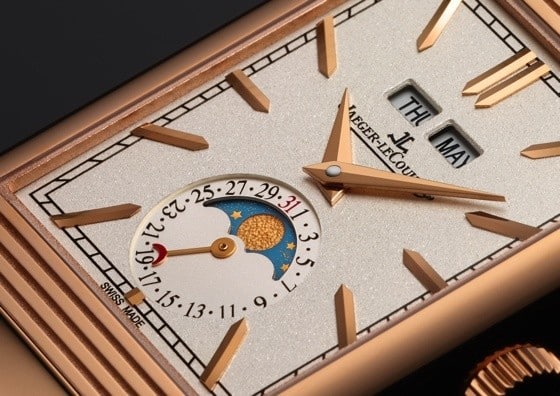The primary function of watches is, of course, to tell the time. They do, however, do a lot of other things which can be used as criteria for a collection. Be it quartz or automatic, a complicated movement can only add to the intrinsic value of a watch, as well as having visual appeal. Fashions and fads may come and go in the watchmaking industry as in any other business, and in the late 1980s the public was crying out for moonphase wrist watches, not realizing that these, in a variety of forms, had been around for a number of years. Because of this craze, older pieces with moonphases and other complicated movements fetched record prices in the international auction rooms.
The collector’s main concern is the beauty of the wrist watch itself, the hours of labor that have gone into creating it, and the dedication of watchmakers past and present whose whirst for knowledge made them look further and further into the possibilities of their craft. Such watches need not be prohibitively expensive, for with care and research it is possible to find some very interesting pieces at reasonable prices. This chapter is designed to help you recognize what you are looking at when you encounter it, rather than simply staring at a watch face and seeing a mass of hands and dials without having any idea as to their function and how to use them.
When you have bought a watch with a complicated movement, handle the mechanism with care, especially when no instructiions are available; do not attempt to adjust it or set the various displays until you are sure that you know what you are doing. If necessary, find an expert and ask for explanations. In fact, although the watch may look very complicated, this is rarely the case, and once you have mastered the basic technique you will find that there are very few variations.
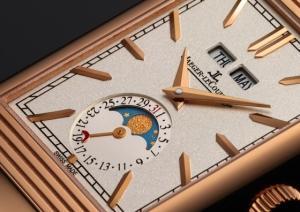
The World Timers
With the increase in travel for both business and pleasure, it has become more important to have a watch on which the different time zones can be seen at a glance. This is also true for the business person who works with communications networks spanning the world. The principle of time-zone movement is quite simple: a rotating disk or interior bezel is marked with the name of a major city from each of the twenty-four time zones and an extra set of hands or another dial will track the time of the chosez zone. For a long time, there have been watches capable of giving the time in two different time zones and even keeping track of two different dates. Of course, in the case of quartz movements, all these functions are spectacular in themselves. For an automatic movement, the difficulty lies in fitting in the extra bezels or dials plus the additional set of hands, together with a date window or dial, without making the watch very awkward to operate and at the same time keeping the buttons and winders to a minimum. The finer the manufacture of these movements, the thinner the movement will be; after all, these are not necessarily sports watches, and a certain degree of elegance is required.
Power Reserve
The reserve de marche, or power reserve, is a feature found on some automatic wrist watches, sometimes paired with another feature such as a world timer, but frequently by itself. The power reserve indicates how many hours the watch will run if left untouched. The power reserve is generally shown by a single hand running over a scale numbered either from 1 to 36 or from 1 to 48, depending on the type of movement.
Minute Repeaters
A minute repeat movement is the only one which tells the time by sound, and it first appeared in wrist watches at the beginning of the twentieth century. At the push of a button, the watch can be set to strike the hours, quarter-hours, and minutes. This is possible through a compex mechanical memory, the creation of which combines the watchmaker’s art with that of the metallurgist, whose skills are needed for the manufacture of the hammers and gongs. There must be at least two different tones available, in order to differentiate between hours and quarter-hours, for instance. The idea behind this type of movement is simple: before the advent of luminous paint, it was not possible to tell the time in the dark visually, so another method had to be found – hence the minute repeater. A pioneering company in this field is Audemars Piguet, which claims to have produced the smallest minute repeater movement in the world. Audemars Piguet is also unusual in that it produces a rectangular minute repeater, which certainly adds to the collectibility value.
Alarm Wrist Watches
As with the minute repeater, the problems of making an alarm wrist watch with an automatic movement are not just horological, but also metallurgic. Unlike in a quartz movement, where an electronic sound can easily be produced, there must be metal striking metal to produce a sound.
One of today’s most famous alarm wrist watches is surely the Grand Reveil by Jaeger-LeCoultre. A most interesting feature is the alloy used for its gong, which dates back to the Chinese Bronze Age, when it was well known for producing a clear and pure sound. This gong is kept separate from the movement so that its vibrations will not have a detrimental effect. For Jaeger-LeCoultre, the Grand Reviel is the culmination of many years’ experience of manufacturing mechanical alarm wrist watches; another of the company’s famous products was the Memovox wrist watch, made during the 1950s, which was the first automatic wrist watch to feature an alarm function.
A contemporary automatic alarm watch made by Maurice Lacroix, which combines a good sound with good looks, is worth looking out for because of the scarcity value of mechanical alarm wrist watches.
The Moonphase
The moonphase indicator on a watch dial can turn the banal into the special. Some of the movements linked to the indicator can be quite simple, merely showing a rotating moon which can be set more or less accurately. Others will take into account the lunar month, showing the twenty-nine and a half days with the various phases of the moon positioned accordingly.
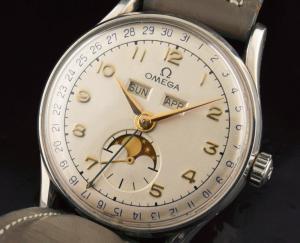
Until recently, Cartier produced a moonphase movement (quartz) for its Santos range, which was, unusually, available as a lady’s or a man’s model.
It is comparatively rare to find a moonphase indicator on its own; it is frequently linked with a date display.
Calendar Movement
A proper calendar movement does not just indicate the date; in general it includes day and date, month and, perhaps, a moonphase. A quartz calendar movement will normally be programmed to take into account the different lengths of the months, but an automatic one will not unless it is a perpetual (a self-winding automatic) movement. It is important to make sure that the displays for the day/date/month are correctly synchronized; if they are not, the information will be incorrect.
The information is displayed by one of three methods: dial or windows or a combination of both. There is not set rule as to the position of each of these, so when purchasing a calendar watch, simply look for one that you find most legible and esthetically pleasing. Some people maintain that the more dials there are on a watch face, the harder it is to absorb the information at a glance, and this is perhaps true of watches where the design and final appearance have not been though thoroughly in the planning stage. However, you will soon be able to differentiate between a good dial design and a bad one that imparts confusing information or misleads the eye.
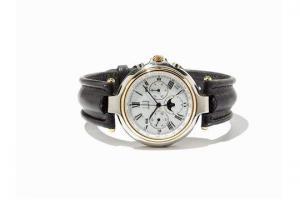
The first perpetual calendars are thought to have appeared around 1853. A perpetual calendar movement takes up where the ordinary calendar movement leaves off. This movement should require no adjustment for leap years, thanks to a complicated system of wheels and satellite wheels or bearings, generally linked to the month display. In most cases, the watch’s calendar display need not be touched until the year 2100 when, because of Pope Gregory XII’s reform of our calendar in 1582 (whereby the year consists of 365 days and a leap year occurs when the year’s number is divisible by four), either a minor adjustment will need to be made or a small part will have to be changed. In case of the latter, do make sure that the part is supplied with the watch!
Quantieme Perpetuel
The feature known as quantieme perpetuel, which is often linked to a calendar or perpetual calendar function, indicates the ability of the watch to adjust itself to the specific number of days in each month: twenty-eight, twenty-nine, thirty or thirty-one. Again, the term relates just to mechanical watches; it is possible to have this function only if there is some kind of mechanical memory built into the watch’s movement.
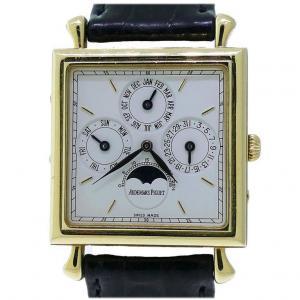
Perpetual Calendar
The perpetual calendar wrist watch sometimes comes with a year indicator on the face. This is a window, not a dial, to avoid the confusion of having yet another hand which would, after all, remain static for a year. If, when setting the date on a perpetual calendar, you go past the current year, the watch will have to be sent back to the manufacturer for resetting.
Grande Complication
Only attempted by the very few, the Grande Complication is a combination of minute repeat, chronograph, and perpetual calendar movements. A piece with this kind of movement is a collector’s item even before it leaves the drawing board and is the direct result of centuries of Swiss watchmaking tradition, combining today’s technology with yesterday’s craftsmanship.
Although the case will be made of the most precious of metals, this is one of the few instances where the movement is infinitely more valuable than the case. Grandes Complications first appeared in the second half of the nineteenth century, and all seem to have originated in the Vallee de Joux, near Geneva in the heart of the Swiss Alps which was then, as now, the center of the Swiss watchmaking industry. Their mechanisms were so precise that 0.001 mm could make a difference to the performance of the watch, aided by movements in which more than 650 parts were not unheard of. The wrist watch versions of the Grande Complication movement were first produced only in the late 1980s, but they are sought by international callectors and are probably not the easiest pieces for the amateur collector to find. It is very important to be awere of their existance; they are, after all, to watches what the Koh-i-Noor is to diamonds. Blancpain has produced a Grande Complication which includes a tourbillon (see below) and a split-second chronograph (stopwatch).
From start to finish, IWC’s Grande Complication required seven years to produce. With such important pieces, it is not surprising that the instructions take the form of a full-size book and that each watch is individually hand-engraved with its own number.
The Grande Complications are mainly available in simple unadorned cases of gold or platinum; with perfection inside, outside embellishments are not required and to add anything further would undoubtedly spoil the overall effect.
The Tourbillon
The tourbillon is generally held to be the brainchild of Abraham-Louis Breguet, who applied for the patent in February 1798. It forms part of a mechanical watch’s movement and relates to the accuracy. It is found only on watches of superlative quality.
The power from the mainspring is controlled through the escapement, the balance wheel, and the balance spring. When the watch is worn, the natural pull of gravity can adversely affect the rate of the movement so, to compensate, the balance wheel and escapement are enclosed in a cage mounted on a pivot. This cage rotates on itself, generally once a minute, to correct any shift in position caused by outside movement, thus keeping the rate constant. The tourbillon is often visible, being part of a skeleton watch (whereby the center of the dial is cut away to reveal the interior mechanism), or seen through a window on a dial or possibly through a glass back.
Obviously, such a sophisticated mechanism tends to make the watch a little more expensive. However, from a collector’s point of view, it is well worth the investment. Such are the difficulties involved in the manufacture of a tourbillon that only the very large, prestigious watch houses will attempt it: Blancpain, Jaeger-LeCoultre, and Girard-Perregaux, for instance. Jaeger-LeCoultre have produced a Reverso with a tourbillon, combining the beauty of a Reverso case with the sophistication of the tourbillon movement.
